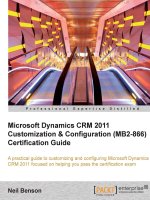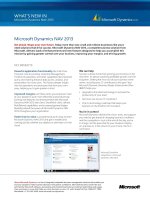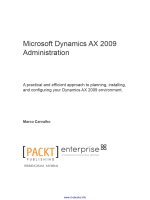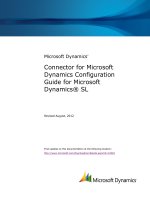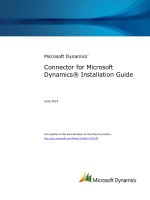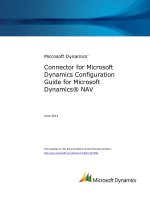Microsoft dynamics NAV financial management
Bạn đang xem bản rút gọn của tài liệu. Xem và tải ngay bản đầy đủ của tài liệu tại đây (9.87 MB, 134 trang )
www.it-ebooks.info
Microsoft Dynamics NAV
Financial Management
Delve deep into the world of financial management
with Microsoft Dynamics NAV
Cristina Nicolàs Lorente
Laura Nicolàs Lorente
BIRMINGHAM - MUMBAI
www.it-ebooks.info
Microsoft Dynamics NAV Financial Management
Copyright © 2013 Packt Publishing
All rights reserved. No part of this book may be reproduced, stored in a retrieval
system, or transmitted in any form or by any means, without the prior written
permission of the publisher, except in the case of brief quotations embedded in
critical articles or reviews.
Every effort has been made in the preparation of this book to ensure the accuracy
of the information presented. However, the information contained in this book is
sold without warranty, either express or implied. Neither the authors, nor Packt
Publishing, and its dealers and distributors will be held liable for any damages
caused or alleged to be caused directly or indirectly by this book.
Packt Publishing has endeavored to provide trademark information about all of the
companies and products mentioned in this book by the appropriate use of capitals.
However, Packt Publishing cannot guarantee the accuracy of this information.
First published: October 2013
Production Reference: 1161013
Published by Packt Publishing Ltd.
Livery Place
35 Livery Street
Birmingham B3 2PB, UK.
ISBN 978-1-78217-162-1
www.packtpub.com
www.it-ebooks.info
Credits
Authors
Project Coordinator
Cristina Nicolàs Lorente
Akash Poojary
Laura Nicolàs Lorente
Proofreader
Lawrence A. Herman
Reviewers
Stefano Demiliani
Indexer
Mylia S. Rubanzana
Hemangini Bari
Acquisition Editors
Graphics
Harsha Bharwani
Ronak Dhruv
Akram Hussain
Commissioning Editor
Deepika Singh
Technical Editor
Jinesh Kampani
Production Coordinator
Kirtee Shingan
Cover Work
Kirtee Shingan
Cover Image
Valentina Dsilva
www.it-ebooks.info
About the Authors
Cristina Nicolàs Lorente has been working with Dynamics NAV since 2005.
She started in the ERP world as a developer, but soon evolved to a complete
Dynamics NAV professional, doing all the tasks involved in Dynamics NAV
implementation: consultancy, analysis, development, implementation, training,
and support to end users.
When Cristina started developing solutions for Dynamics NAV she had no idea
about accounting or about any kind of business workflows. They don't teach those
kind of things for a technical university career. Soon she discovered that it
is important to know the set of tools used, but even more important to understand
the meaning of whatever you develop. Without knowing the accounting rules,
practices, and legal requirements, it is impossible to develop useful accounting
functionalities even if you are the best developer. Only when you fully understand
a company's processes you will be able to do the appropriate developments.
Having that in mind, she has taken courses in Accounting, Warehouse
Management, and Operations Management. She is also willing to take courses
on any other company related topics.
She thinks that the best way to learn is to teach what you are learning to someone
else. She has actually learned almost everything she knows about Dynamics NAV
by responding to user questions on internet forums, by writing a blog about
Dynamics NAV, and of course by writing the book you have in your hands. When
you have to write about something, you have to experiment, try, investigate, and
read. It is definitely the best way to learn.
Cristina is also co-author of the book Implementing Microsoft Dynamics NAV 2013,
which had really good comments coming from different Dynamics NAV experts.
www.it-ebooks.info
Acknowledgments
I would like to thank Isabel, who has supported me on this project. She has always
believed in me and she has been pushing me to find the time invested on this book.
Without her, this project would have been much more difficult than it turned out to be.
I would also like to thank Laura, my sister and colleague, the coauthor of this book,
for being always positive about what you can reach with effort, discipline, and
confidence of your own possibilities. She is the one who encouraged me to write
this book.
A special thanks to Josep and Josep Maria. They have given me an opportunity
to professionally evolve. They have always believed in me and have given me
the needed confidence to take my own steps and responsibilities.
The final thanks goes to all my colleagues and customers, and also for all the
people who helped me to learn by posting questions on the forums. You have
all contributed to build the professional, I am today.
www.it-ebooks.info
Laura Nicolàs Lorente started to work with Dynamics NAV back in 2005, first
in the support department, mostly solving functional issues and doubts. She soon
jumped to full deployment: consulting, analysis, development, implementation,
migration, training, and support.
Right from the beginning she realized that it was very important for a Dynamics
NAV consultant to have a deep knowledge of business workflows. Technical skills
are just not enough. So she started to train herself accounting, taxation, supply
chain, logistics, and so on. She discovered a whole new world and she found it
very interesting.
After having enough consultancy experience, she got to manage the first project
on her own. And then she realized that tech and business knowledge is not enough:
she also needed management skills. This is why after reading different management
books and trying different approaches on the projects she worked on, she decided
to deepen her knowledge by taking a Masters in Project Management. She is now
transitioning to Agile Management and Agile Development for better project success.
She continues her training in the three areas (tech, business workflows, and
management) whenever she gets the chance.
The net is a huge source of inspiration for her: groups, forums, blogs, books, and
so on. She also contributes by sharing her knowledge and experience with the
Spanish Dynamics NAV community.
Laura is also co-author of the book Implementing Microsoft Dynamics NAV 2013,
which had really good comments coming from different Dynamics NAV experts.
www.it-ebooks.info
I would like to dedicate this book to Roc and Quim, my twin sons that were born
while writing this book. Being a mum has changed me and my life, and I am really
happy with it. A new life starts from now on. I hope I will be able to teach them
the values I learned from my parents, that made me be the person I am.
I also want to dedicate it to Rosa, my wife, who gave birth to such beautiful babies.
She is the pillar onto which I hold, and the person that gives me the energy I need
to keep going.
I would like to thank Cristina. She is my sister, my friend, and my colleague.
We both wrote this book and had a great time together while writing and learning.
I wish us many successful projects together, now and in the future.
Also thanks to my family, friends, colleagues, managers, and customers who
helped me grow. And a special recognition to my forum and blog followers for
their comments. It is nice to know that you are helping people and that they thank
you for that.
www.it-ebooks.info
About the Reviewers
Stefano Demiliani is a Microsoft Certified Solution Developer, MCTS on Microsoft
Dynamics NAV, and MCTS on Sharepoint, and different .NET technologies.
He has a Masters degree in Computer Engineering from Politecnico of Turin.
He works as a Senior Project Manager and Solution Developer for EID/Navlab
(one of the biggest Microsoft Certified Partners in Italy) and his main activity
is architecturing and developing solutions based on Microsoft technologies.
He has written many articles and blogs on different Microsoft related topics
(.NET, Sharepoint, Microsoft Dynamics) and he's frequently involved in consulting
on these topics.
You can get more details and keep in touch with him by reaching the site
or via Twitter (@demiliani).
www.it-ebooks.info
Mylia S. Rubanzana (MBA, MABR, PGDFM, BCOM, and DIP) is currently
a Finance Manager at Uganda National Council for Science and Technology. Mylia
has over 20 years of working experience specializing in financial management. Mylia
is a Member of the International Consortium on Governmental Financial Management
and a Council Member of Uganda Technology and Management University.
In 2011, he proposed an implementation plan for the Science, Technology, and
Innovation Fund. He worked on System Financing in the Science, Technology
and Innovation benchmarking study of Finland. Also, he performed an assessment
of the budget performance management in the public sector the Uganda: a case
study of Uganda National Council for Science and Technology. He established the
China-Uganda Scientific and Cultural Village in Uganda. In 2010, he participated
in transfer and commercialization of charcoal manufacturing technology for farmers
and entrepreneurs in Uganda. In 2005, he worked on Accounting information system
and quality of financial reporting at some Public institutions in Uganda: Case study
of Uganda National Council for Science and Technology. Later, he worked on
a financial procedural manual for Science and Technology. In 2002, he worked
on Financial procedural Manual for the National Civic Education Program. In 1990,
he wrote an extended essay on Gold Trust Bank.
www.it-ebooks.info
www.PacktPub.com
Support files, eBooks, discount offers and more
You might want to visit www.PacktPub.com for support files and downloads related
to your book.
Did you know that Packt offers eBook versions of every book published, with PDF
and ePub files available? You can upgrade to the eBook version at www.PacktPub.
com and as a print book customer, you are entitled to a discount on the eBook copy.
Get in touch with us at for more details.
At www.PacktPub.com, you can also read a collection of free technical articles, sign
up for a range of free newsletters and receive exclusive discounts and offers on Packt
books and eBooks.
TM
Do you need instant solutions to your IT questions? PacktLib is Packt's online digital book
library. Here, you can access, read and search across Packt's entire library of books.
Why Subscribe?
• Fully searchable across every book published by Packt
• Copy and paste, print and bookmark content
• On demand and accessible via web browser
Free Access for Packt account holders
If you have an account with Packt at www.PacktPub.com, you can use this to access
PacktLib today and view nine entirely free books. Simply use your login credentials
for immediate access.
Instant Updates on New Packt Books
Get notified! Find out when new books are published by following @PacktEnterprise
on Twitter, or the Packt Enterprise Facebook page.
www.it-ebooks.info
Table of Contents
Preface1
Chapter 1: The Sales and Purchase Process
7
Introducing Microsoft Dynamics NAV
8
Importance of Financial Management
10
Posted data cannot be modified (or deleted)
10
No save button
11
Understanding master data
12
Customers12
Items15
Vendors, resources, and locations
17
Pricing17
Defining sales prices
18
Defining sales discounts
20
Purchase pricing
22
Documents23
Document workflows
28
Document approval
29
Summary30
Chapter 2: Managing Payments and Banks
31
Managing due dates
31
Payment terms
32
Prepayments33
Using credit cards and other payment methods
33
Posting payments
34
Suggesting vendor payments
36
Creating and printing checks
36
www.it-ebooks.info
Table of Contents
Checking customer and vendor balances
37
Which invoice has been paid?
38
Bank reconciliation
38
Summary40
Chapter 3: Accounting Processes
Posting accounting transactions
Standard journals
Recurring journals
41
41
43
44
Allocations45
Reporting taxes – VAT
VAT Settlement
VAT Statements
Managing fixed assets
Creating a fixed asset and posting its acquisition cost
Revaluating fixed assets
Calculating depreciation
Selling or disposing a fixed asset
Canceling fixed asset entries
Inventory valuation
Choosing a costing method
Calculating item entries costs
46
47
49
50
50
52
53
54
55
55
56
56
Posting inventory valuation to the general ledger
Inventory valuation report
Closing the accounting year
Closing accounting periods
Running the Close Income Statement batch process
Restricting the allowed posting dates
Posting transactions on a closed year
Consolidating financial statements
Performing consolidation
57
58
59
60
60
62
62
62
63
Inbound entries
Outbound entries
Consolidating on single database
Consolidating with different databases
Consolidating with other applications
Reporting over a consolidated company
Setting it up
Defining business units
Translating a chart of accounts
56
57
63
64
65
66
66
67
68
Summary68
[ ii ]
www.it-ebooks.info
Table of Contents
Chapter 4: Reporting and Business Intelligence
Understanding dimensions
Defining default dimensions on master data
Using dimensions on documents and journals
Using filters and flowfilters
Applying filters on pages
Applying flowfilters on pages
Creating views
Using reports
Displaying charts
Show as a chart option
Adding charts to the role center page
Using account schedules
Analysis views
Creating analysis views
Using analysis views
Analysis by dimensions
Analysis views as a source for account schedules
Business Intelligence with Excel and PowerPivot
Summary
69
69
70
71
72
72
73
74
75
76
76
77
77
80
80
81
81
82
83
85
Chapter 5: Foretelling – Budgeting and Cash Flow Management
87
Chapter 6: Financial Management Setup
99
Budgets
Creating budgets
Using budgets
Cash flow management
Creating manual expenses and revenues
Cash flow management setup
Summary
87
88
91
92
95
96
97
Understanding posting groups
99
Specific posting groups
100
General posting groups
101
VAT posting groups
102
Setting up dimensions
103
Number series
104
General setup
105
Summary107
[ iii ]
www.it-ebooks.info
Table of Contents
Chapter 7: Other Financial Functionalities
109
Currencies
109
Intercompany postings
110
Accounting implications of other areas
111
Jobs111
Service111
Warehouse111
Manufacturing112
XBRL
112
Summary112
Index113
[ iv ]
www.it-ebooks.info
Preface
Dynamics NAV is an Enterprise Resource Planning (ERP) system targeted at small
and medium-sized companies. An ERP is a system, a software, which integrates the
internal and external management information across an entire organization. If you
search the net you will find plenty of documentation, webs, forums, and all kinds
of information covering Dynamics NAV from many technical points of view. But
you will find nothing or little covering Dynamics NAV from a functional point of
view, meant for end users. Thousands of users from all around the world that use
Dynamics NAV as their main tool for daily work complain that they cannot find
information about what they need from the system. And they are right.
This book is written for them, after the experience of giving training to many end
users in each implementation we have worked on. We have found out that most
users do not care about system configuration; they just want to know how the system
works. They contact Dynamics NAV consultants to set up when needed. But in the
little end user documentation found, each topic starts with a full setup introduction
that confuses readers and may even discourage them from reading further.
In this book we have changed the established structure of official manuals. Instead
we have used a logical structure that makes it easy to read and very easy to
understand. This is how we teach Dynamics NAV in our training sessions and this
is how people tell us they have learned and understood the application.
Don't think this book is only meant for financers and accountants. This book is also
meant for Dynamics NAV consultants and developers. You need full Dynamics
NAV functional knowledge to become an expert, and this book can help you with it.
You will never stop learning about new features and functionalities. The idea behind
the book is that you learn enough to be able to keep learning on your own. Every
single field in every single table can hide a mini functionality that is there to help
you with your work.
www.it-ebooks.info
Preface
What this book covers
Chapter 1, The Sales and Purchase Process, explains how these two essential business
areas in all companies can be handled in Dynamics NAV. It also shows how
Dynamics NAV translates all the transactions to accountancy language on the fly.
In this chapter, you will learn how to create new customers and vendors, to set up
your pricing policies, and the documents used when selling and purchasing as well
as their workflows.
Chapter 2, Managing Payments and Banks, discusses that after invoicing companies
have to charge for the items delivered and have to pay for the services received.
In this chapter you will learn how to manage different payment terms and methods,
and to analyze customer and vendor extracts and their outstanding balances.
To check that the statements your bank provides you agree with the payments and
charges you have posted into the system, you can use the Bank reconciliation feature
that is explained in the chapter.
Chapter 3, Accounting Processes, explains how to handle accounting tasks such
as reporting taxes, fixed asset management, inventory valuation, posting payroll
accrual entries, provisions, and other accounting transactions, annual accounting
close, and consolidation with other companies.
Chapter 4, Reporting and Business Intelligence, discusses the tools that can help you
with analysis, both inside and outside the application. The previous chapters teach
readers about the data entry and data process tasks. Once the data
is introduced into the system, you should be able to analyze it.
In this chapter we explain how dimensions can be used to tag entries so that you can
group entries with similar characteristics. This will allow you to report on the data
in a way that is meaningful to the company.
Dynamics NAV has a bunch of reports that can be used out of the box. Account
Schedules and Analysis Views are features that allow users to create their own
reports. You can also use the Business Intelligence tools included in Excel by linking
it with your Dynamics NAV database.
Chapter 5, Foretelling – Budgeting and Cash Flow Management, discusses that
accounting rules are based on faits accompli, but companies need to anticipate and
predict events. In Dynamics NAV budgets are used to plan costs, revenues, and
resources and can be used to set up goals and measure performance. The cash flow
management functionality is meant to help companies to predict future cash needs.
[2]
www.it-ebooks.info
Preface
Chapter 6, Financial Management Setup, explains that in Dynamics NAV everything
leads to accounting, but most of the operations inside Financial Management can be
carried out with little accountancy knowledge. You need to set up the system so that
it can translate transactions to accountancy language according to your company rules.
In this chapter we cover the general setup, the dimensions setup, the creation
and configuration of posting groups, and the definition of number series.
Chapter 7, Other Financial Functionalities, explains briefly about currencies,
intercompany postings, XBRL, and accounting implications on areas such as Jobs,
Services, Warehouse, or Manufacturing. In the previous chapters we have covered
the most important aspects of financial management with Dynamics NAV. But the
application has a lot more possibilities.
What you need for this book
To successfully follow the examples in this book you will need an installation
of Microsoft Dynamics NAV 2013.
Who this book is for
This book is meant for financers and accountants that are using or going to use
Dynamics NAV as their ERP and financial management system.
It is also meant for Dynamics NAV consultants and project managers who will help
organizations to use the system for their daily work.
The book will also be very helpful to Dynamics NAV developers who want to
understand how the standard application is used in organizations, to help them
develop better features, and more integration with the existing ones.
Conventions
In this book, you will find a number of styles of text that distinguish between
different kinds of information. Here are some examples of these styles, and an
explanation of their meaning.
[3]
www.it-ebooks.info
Preface
New terms and important words are shown in bold. Words that you see on the
screen, in menus or dialog boxes for example, appear in the text like this: "click
on the View icon found on the Home tab of the ribbon."
Warnings or important notes appear in a box like this.
Tips and tricks appear like this.
Reader feedback
Feedback from our readers is always welcome. Let us know what you think about
this book—what you liked or may have disliked. Reader feedback is important for
us to develop titles that you really get the most out of.
To send us general feedback, simply send an e-mail to ,
and mention the book title via the subject of your message. If there is a topic that you
have expertise in and you are interested in either writing or contributing to a book,
see our author guide on www.packtpub.com/authors.
Customer support
Now that you are the proud owner of a Packt book, we have a number of things
to help you to get the most from your purchase.
Errata
Although we have taken every care to ensure the accuracy of our content, mistakes do
happen. If you find a mistake in one of our books—maybe a mistake in the text or the
code—we would be grateful if you would report this to us. By doing so, you can save
other readers from frustration and help us improve subsequent versions of this book.
If you find any errata, please report them by visiting />submit-errata, selecting your book, clicking on the errata submission form link,
and entering the details of your errata. Once your errata are verified, your submission
will be accepted and the errata will be uploaded on our website, or added to any list
of existing errata, under the Errata section of that title. Any existing errata can
be viewed by selecting your title from />
[4]
www.it-ebooks.info
Preface
Piracy
Piracy of copyright material on the Internet is an ongoing problem across all media.
At Packt, we take the protection of our copyright and licenses very seriously. If you
come across any illegal copies of our works, in any form, on the Internet, please
provide us with the location address or website name immediately so that we can
pursue a remedy.
Please contact us at with a link to the suspected
pirated material.
We appreciate your help in protecting our authors, and our ability to bring you
valuable content.
Questions
You can contact us at if you are having a problem
with any aspect of the book, and we will do our best to address it.
[5]
www.it-ebooks.info
www.it-ebooks.info
The Sales and Purchase
Process
Sales and purchases are two essential business areas in all companies. In many
organizations, the salesperson or the purchase department are the ones responsible
for generating quotes and orders. People from the finance area are the ones in charge
of finalizing the sales and purchase processes by issuing the documents that have
an accountant reflection: invoices and credit memos.
In the past, most systems required someone to translate all the transactions to
accountancy language, so they needed a financer to do the job. In Dynamics NAV,
anyone can issue an invoice, with zero accountant knowledge needed. But a lot of
companies keep their old division of labor between departments. This is why we have
decided to explain the sales and purchase processes in this book. This chapter explains
how their workflows are managed in Dynamics NAV. In this chapter you will learn:
• What Dynamics NAV is and what it can offer to your company
• To define the master data needed to sell and purchase
• How to set up your pricing policies
• What kind of documents you can issue
• The workflows inside the sales and purchases area
www.it-ebooks.info
The Sales and Purchase Process
Introducing Microsoft Dynamics NAV
Dynamics NAV is an Enterprise Resource Planning (ERP) system targeted at small
and medium-sized companies.
An ERP is a system, a software, which integrates the internal and external
management information across an entire organization. The purpose of an ERP
is to facilitate the flow of information between all business functions inside
the boundaries of the organizations. An ERP system is meant to handle all the
organization areas on a single software system. This way the output of an area
can be used as an input of another area.
Dynamics NAV 2013 covers the following functional areas:
• Financial Management: This includes accounting, G/L budgets, account
schedules, financial reporting, cash management, receivables and payables,
fixed assets, VAT reporting, intercompany transactions, cost accounting,
consolidation, multicurrency, and intrastat.
• Sales & Marketing: This area covers customers, order processing, pricing,
contacts, marketing campaigns, and so on.
• Purchase: The purchase area includes vendors, order processing, approvals,
planning, costing, and other such areas.
• Warehouse: Under the warehouse area you will find inventory, shipping
and receiving, locations, picking, assembly, and so on.
• Manufacturing: This area includes product design, capacities, planning,
execution, costing, subcontracting, and so on.
• Job: Within the job area you can create projects, phases and tasks, planning,
time sheets, work in process, and other such areas.
• Resource Planning: Manage resources, capacity, and so on.
• Service: Within this area you can manage service items, contracts, order
processing, planning and dispatching, service tasks, and so on.
• Human Resources: Manage employees, absences, and so on.
Some of these areas will be covered in detail in this book.
Dynamics NAV offers much more than robust financial and business management
functionalities. It is also a perfect platform to customize the solution to truly fit your
company needs. If you have studied different ERP solutions, you know by now
customizations to fit your specific needs will always be necessary. Dynamics NAV
has a reputation for being easy to customize, which is a distinct advantage.
[8]
www.it-ebooks.info
Chapter 1
Since you will probably have customizations in your system, you might find some
differences with what is explained in this book. Your customizations could imply that:
• You have more functionality in your implementation
• Some steps are automated, so some manual work can be avoided
• Some features behave differently than explained here
• There are new functional areas in your Dynamics NAV
In addition Dynamics NAV has around forty different country localizations that
are meant to cover country-specific legal requirements or common practices.
Many people and companies have already developed solutions on top of Dynamics
NAV to cover horizontal or industry-specific needs, and they have registered their
solution as an add-on, such as:
• Solutions for the retail industry or the food and beverages industry
• Electronic Data Interchange (EDI)
• Quality or maintenance management
• Integration with third-party applications such as electronic shops, data
warehouse solutions, or CRM systems
Those are just a few examples. You can find almost 2,000 registered third-party
solutions that cover all kind of functional areas. If you feel that Dynamics NAV does
not cover your needs and you will need too much customization, the best solution
will probably be to look for an existing add-on and implement it along with your
Dynamics NAV.
Anyway, with or without an add-on, we said that you will probably need
customizations. How many customizations can you expect? This is hard to tell
as each case is particular, but we'll try to give you some highlights.
If your ERP system covers 100 percent of your needs without any customization,
you should worry. This means that your procedures are so standard that there is no
difference between you and your competitors. You are not offering any special service
to your customers, so they are only going to measure you by the price they are getting.
On the other hand if your Dynamics NAV only covers a low percentage of your
needs it could just mean two things: this is not the product you need; or your
organization is too chaotic and you should re-think your processes to standardize
them a bit.
Some people agree that the ideal scenario would be to get about 70-80 percent
of your needs covered out of the box, and about 20-30 percent customizations
to cover those needs that make you different from your competitors.
[9]
www.it-ebooks.info
The Sales and Purchase Process
Importance of Financial Management
In order to use Dynamics NAV, all organizations have to use the Financial
Management area. It is the epicenter of the whole application. All other areas are
optional and their usage depends on the organization's needs. The sales and the
purchase areas are also used in almost any Dynamics NAV implementation.
Actually, accountancy is the epicenter, and the general ledger is included inside
the Financial Management area. In Dynamics NAV everything leads to accounting.
It makes sense as accountancy is the act of recording, classifying, and summarizing,
in terms of money, the transactions and events that take place in the company.
Every time the warehouse guy ships an item, or the payment department orders
a transfer, these actions can be written in terms of money using accounts, credit,
and debit amounts.
An accountant could collect all the company transactions and translate them one-byone to accountancy language. But this means manual duplicate work, a lot of chances
of getting errors and inconsistencies, and no real-time data.
On the other hand, Dynamics NAV is capable to interpret such transactions and
translate them to accountancy on the fly. In Dynamics NAV everything leads
to accountancy, so all the company's employees are helping the financial department
with their job. The financers can now focus on analyzing the data and taking
decisions, and they don't have to bother on entering the data anymore.
Posted data cannot be modified (or deleted)
One of the first things you will face when working with Dynamics NAV is the
inability to modify what has been posted, whether it's a sales invoice, a shipment
document, a general ledger entry, or any other data. Any posted document or entry
is unchangeable.
This might cause frustration, especially if you are used to working with other
systems that allow you to modify data. However, this feature is a great advantage
since it ensures data integrity. You will never find an unbalanced transaction.
If you need to correct any data, the Dynamics NAV approach is to post new entries
to null the incorrect ones, and then post the good entries again. For instance,
if you have posted an invoice and the prices were wrong, you will have to post
a credit memo to nullify the original invoice and then issue a new invoice with
the correct prices.
[ 10 ]
www.it-ebooks.info

